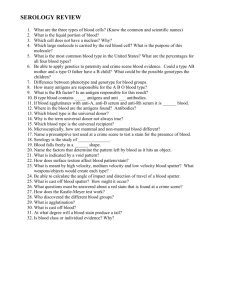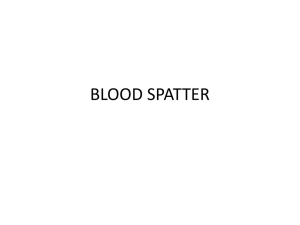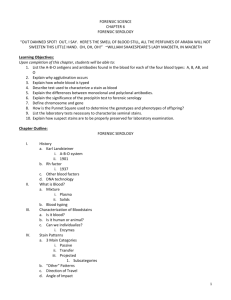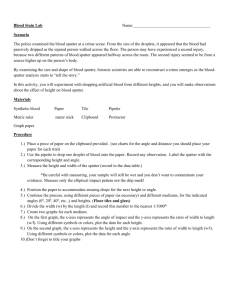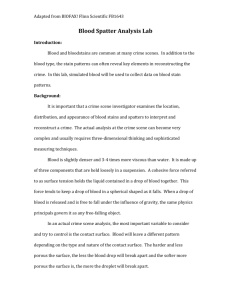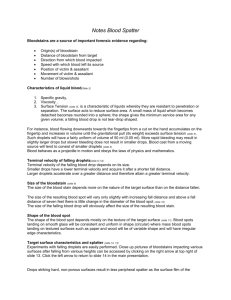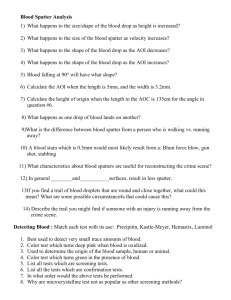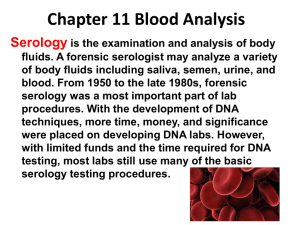Ch. 8: Blood Spatter What constitutes a “blood spatter pattern”? I
advertisement
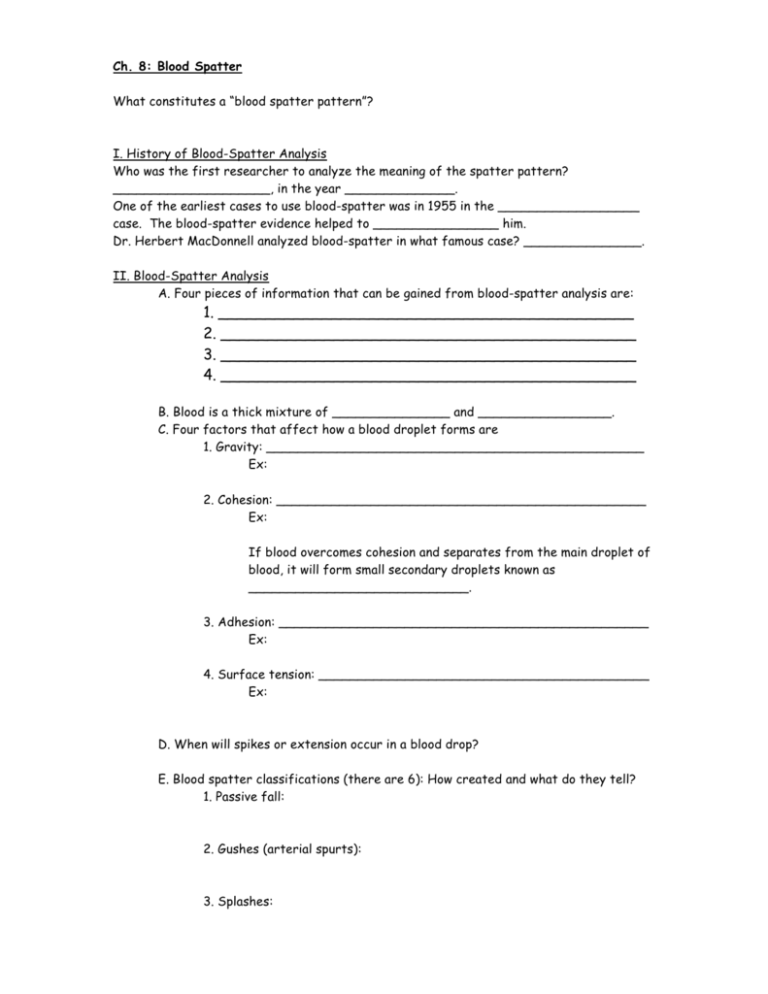
Ch. 8: Blood Spatter What constitutes a “blood spatter pattern”? I. History of Blood-Spatter Analysis Who was the first researcher to analyze the meaning of the spatter pattern? ____________________, in the year ______________. One of the earliest cases to use blood-spatter was in 1955 in the __________________ case. The blood-spatter evidence helped to ________________ him. Dr. Herbert MacDonnell analyzed blood-spatter in what famous case? _______________. II. Blood-Spatter Analysis A. Four pieces of information that can be gained from blood-spatter analysis are: 1. ____________________________________________ 2. ____________________________________________ 3. ____________________________________________ 4. ____________________________________________ B. Blood is a thick mixture of _______________ and _________________. C. Four factors that affect how a blood droplet forms are 1. Gravity: ________________________________________________ Ex: 2. Cohesion: _______________________________________________ Ex: If blood overcomes cohesion and separates from the main droplet of blood, it will form small secondary droplets known as ____________________________. 3. Adhesion: _______________________________________________ Ex: 4. Surface tension: __________________________________________ Ex: D. When will spikes or extension occur in a blood drop? E. Blood spatter classifications (there are 6): How created and what do they tell? 1. Passive fall: 2. Gushes (arterial spurts): 3. Splashes: 4. Smears: 5. Trails of blood: 6. Pools: F. Determining the Type of Wound 1. A fine mist pattern = 2. Lower velocity pattern = 3. Voids might tell us = 4. Point of Origin: (use definition in back of book!) III. Examination of Directionality of Blood A. A circular drop of blood indicates that the blood _____________________ ____________________________________________________________ B. An elongated drop of blood can tell us ______________________________ C. What are those three forces again that affect a moving drop of blood? ____________________________________________________________ Which one did they forget that you learned about earlier? ________________ D. Due to adhesion, the point of impact may appear to be _______________ and _______________ than the rest of the drop of blood spatter. E. What is momentum? (you might have to look this up on the Internet!) _________ ______________________________________________________________. How does this relate to Newton’s 1st Law of Motion? _______________________ ______________________________________________________________. Momentum tends to keep the blood ____________________________________. Direction of movement? F. As blood droplets move away from their source, the blood droplet _____________________ and may produce a thinner _____________________. The tail points in the direction of the blood’s ____________________________. Satellites that break off will appear ____________________ the moving droplet. IV. Lines of Convergence A. The location of the source of blood can be determined if there are at least ______ drops of blood spatter. B. By drawing lines down the long axis of the blood spatter and noting where the lines intersect, you can determine the ________________________________. C. If there are numerous blood spatters, how do you find the source where the blood originated? ________________________________________________ V. Blood Spatter Types Examine the bloodstain pattern below. Determine the number of each size drop. Find the percent frequency of each droplet size and determine which size is preponderant (more common). Width of stain Stain size (width in mm) # of stains % Frequency Upon examining blood spatter in many crime scenes, forensic experts noticed a relationship between the size of a blood spatter and the velocity of the wounding agent. This relationship led them to a vital clue in deciphering the type of weapon or wounding agent that caused the blood spatter at a crime scene. The impact velocity was categorized as low impact, medium impact, or high impact velocity. Experts have determined that a low-impact velocity wounding agent generally produces a spatter of at least 4 mm in size. A medium-impact velocity wounding agent produces spatter with size between 1 and 4 mm. A high-impact wounding agent produces spatter with size ranging from 0.1 to 1 mm. Summarize this information in the table below. Type of Velocity Range Spatter Size Possible Wounding Impact (width of droplets) Agents According to the data that you tabulated above, what is the relationship between the impact velocity of the wounding agent or weapon and the size of the blood spatter? Velocity (v) Based on what you’ve learned, give a possible wounding agent that produced the pattern? Preponderant Stain Size (s)
